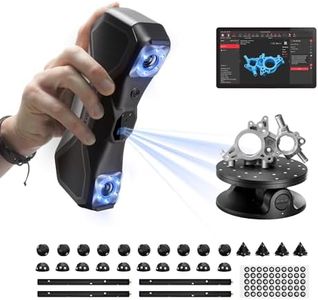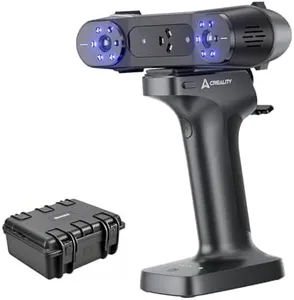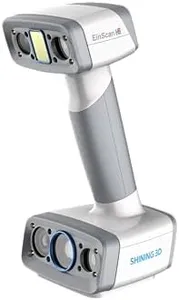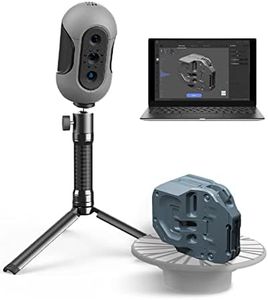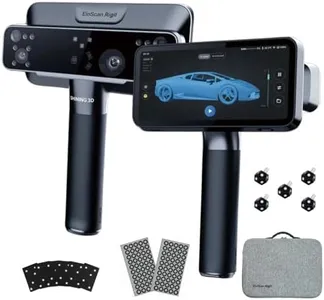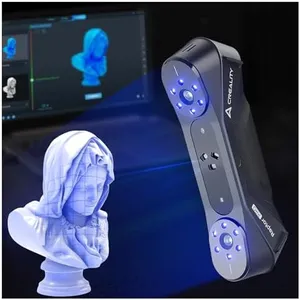10 Best 3D Scanners 2025 in the United States
Our technology thoroughly searches through the online shopping world, reviewing hundreds of sites. We then process and analyze this information, updating in real-time to bring you the latest top-rated products. This way, you always get the best and most current options available.

Our Top Picks
Winner
2024 EinScan Pro HD Handheld 3D Scanner with Industrial Pack & Color Pack HD, SolidEdge Shining3D CAD Software for Reverse Engineering, Healthcare, Manufacturing, Research, Art and Design
The 2024 EinScan Pro HD Handheld 3D Scanner is a versatile tool suitable for various applications including reverse engineering, healthcare, manufacturing, and art and design. With a resolution of 3600, it offers impressive detail, making it a great choice for professionals who need high-quality scans. Its portability is a significant advantage, weighing only 2.36 pounds, which ensures ease of use in different environments. The scanner's accuracy and decent scanning speed make it efficient for projects that require precision without extensive waiting time.
One of the standout features is its software compatibility, particularly with the SolidEdge Shining3D CAD Software, which enhances its functionality for design and engineering tasks. The scanning range is suitable for most applications, allowing users to capture both small and larger objects effectively.
However, there are some drawbacks to consider. The minimum system requirement of Windows 7 might limit accessibility for users with newer operating systems. Additionally, while its portability is a plus, the package dimensions suggest it might not be the easiest to transport in all situations. Some users might also find the learning curve steep if they are unfamiliar with 3D scanning technologies. While it ranks well among industrial scanners, it is important to compare it with other models to ensure it fits specific needs and budget constraints.
Revopoint MetroX 3D Scanner for 3D Printing, Handheld 3D Printer Scanner Blue Laser Scan, Metrology-Grade Precision 0.01mm for Metal Dark Object, Up to 60fps Speed, Support Windows macOS, Advanced
Most important from
74 reviews
The Revopoint MetroX is a handheld 3D scanner designed for high-precision tasks such as industrial measurement, quality control, and 3D printing. It offers an impressive accuracy of up to 0.01 mm and a resolution with a fused point cloud distance of 0.05 mm, allowing it to capture very fine details, especially useful for scanning metal or dark objects without needing spray. The scan speed is quite fast, reaching up to 60 frames per second and capturing up to 7 million points per second in its full-field mode, making it efficient for detailed work.
This scanner features multiple scanning modes, including an automated turntable option that simplifies the scanning process and enhances ease of use, particularly for desktop setups. It supports various tracking modes to handle different surface types, from detailed textures to plain or complex shapes, enhancing its versatility. The included professional software (Revo Scan 5 MetroX) supports multiple file formats and is tailored for advanced editing and CAD workflows, though it requires relatively powerful computer specs (a recent Intel i7 or Ryzen 7 with ample RAM and optional GPU), which might limit casual users with older machines.
Regarding portability, the device weighs nearly 15 pounds with its packaging and includes a tripod and turntable, so while it’s handheld, it is better suited for stable, semi-stationary scanning rather than fully mobile use. USB 3.0 compatibility ensures a solid connection but requires a modern PC port. This makes the MetroX ideal for professionals needing detailed, accurate scans of challenging materials and shapes, with strong points in precision, versatile scanning modes, and robust software, though it demands a powerful computer and is not the easiest option if a lightweight, fully portable scanner is preferred.
Most important from
74 reviews
Creality 3D Scanner Raptor Pro and Scan Bridge Wireless Scanning, 3D Scanner for 3D Printing, High Precision 0.02mm, 60FPS Scanning Speed, 22+7 Blue Laser Lines
Most important from
8 reviews
The Creality Raptor Pro 3D Scanner is designed for users who need high precision and fast scanning, making it a solid choice for 3D printing enthusiasts and professionals alike. It offers ultra-high accuracy with up to 0.02mm precision, which means it can capture fine details very well. The scanning speed is impressive at 60 frames per second, allowing for quick data capture without long waiting times. The wide scanning range supports objects from very small (5mm) to quite large (up to 2000mm), which gives flexibility for various projects.
Portability might be average since the package is a bit bulky at over 12 pounds, but the wireless scanning feature adds convenience by reducing cable clutter and improving ease of movement during use. The scanner also supports full-color mapping, which helps create realistic textures on digital models, and uses marker-based alignment to simplify the process of combining multiple scans into one complete image. The included Scan Bridge should make setup and operation straightforward for most users.
This scanner successfully balances strong technical performance with user-friendly features, making it a versatile tool. However, those needing a lightweight, ultra-compact scanner might find this model less ideal.

